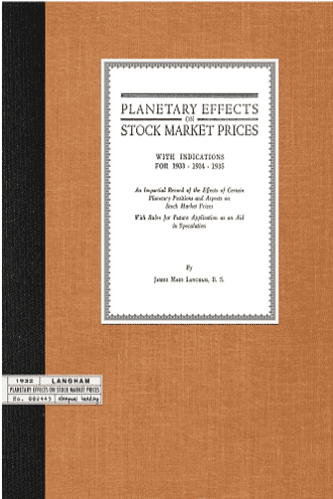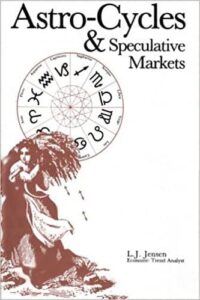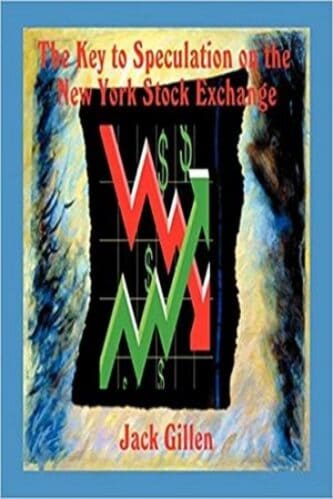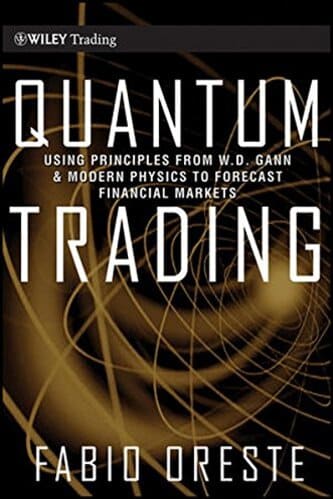Articles
The Future of Financial Astrology By Patrick Mikula
The history of financial astrology is quite fascinating. It is a known fact that some of the greatest market traders and forecasters used financial astrology but the method has never been able to gain wide support in the financial community. The reason for this lack of acceptance is that financial astrology has always been a very discretionary approach to trading and requires a large amount of time just to learn the basics. At the Vibration Research Institute we are working to automate financial astrology into what we have named Mechanical Astrology. This term refers to fully mechanical astrology trading systems.
In this article we are going to discuss two simple Mechanical Astrology trading systems. The first step when setting up an astrology trading system is to identify an astrological event which correlates to the financial markets. For the first system we will use the observation that the moon phase often correlates with swing tops and bottoms. We will use the four main positions of the moon phase, which are the first quarter moon, the full moon, the third quarter moon and the new moon. To generate our buy and sell logic, we will combine the lunar phase with the Stochastic which is the best known momentum indicator. If the observation that the moon phase correlates with swing tops and bottoms is true then we should be able to combine a bottom in the Stochastic and the moon phase for a buy signal and a top in the Stochastic and the moon phase for a sell signal. To further test the correlation of the moon phase to the markets, we will also use a moon phase to exit each trade. So the buy long logic for this system will read, buy if X moon phase occurs and the Stochastic is below 20. Then exit long when Y moon phase occurs. The sell short logic for this system will read, sell if X moon phase occurs and the Stochastic is above 80. Then exit short when Y moon phase occurs.
Our final question for this system is which moon phase do we use for X and Y? This question is best answered by the computer. For this type of system testing we use the AstroTrader program which is an add-on for TradeStation or SuperCharts. We write this system in Easy Language and then use the TradeStation system tester to run this system with all possible combinations to show us which moon phase correlates with a particular market. When this system is tested back to 1990 on soybean futures using a continuous contract, we find that using the New Moon for the entry and the Full moon for the exit had the highest correlation. This produces 44 trades with an overall 66 percent profitability with the long trades being 54 percent profitable and the short trades being 88 percent profitable. The system logic for soybeans would read, buy long if a new moon occurs and the Stochastic is below 20, then exit long on the next full moon. Sell short if a new moon occurs and the Stochastic is above 80, then exit short on the next full moon.
Suggested Books and Courses About Astro Trading
The second trading system we will discuss will not use any traditional technical indicators such as the Stochastic. Instead we will discuss a system based only on an astrological correlation to a financial market. We will try to find a correlation between a planet crossing into a new zodiac sign (which is called ingress) and the movement of the crude oil market. We will write the system to test the activity leading up to the ingress and following the ingress. There are two possible buy signals and two possible sell signals. The first possible long signal is, buy long X bars before Y ingress and exit on Y ingress date. The second possible long signal is, buy long on Y ingress date and exit X bars after Y ingress date. The first possible sell signal is, sell short X bars before Y ingress and exit on Y ingress date. The second possible sell signal is, sell short on Y ingress date and exit X bars after Y ingress date.
The final question concerns what planetary ingress do we use for the Y ingress date and how many bars do we use for X. These questions are answered by programming this buy and sell logic into TradeStation using the AstroTrader program and then using the system tester. Crude oil futures were tested using a continuous contract from 1990 to the present. The system tester tested all ingress for heliocentric planets. We found that there was a correlation between crude oil prices rising and the Mercury ingress into Cancer and Virgo. After 36 trades there was 67 percent winners if the system bought five days before the Cancer ingress and 65 percent winners if the system bought five days before the Virgo ingress. Correlations also occurred using the other planets but there were considerably fewer trades because of the longer orbit times so we have not included them. After running all the tests and finding which planet and which ingress correlates to the crude oil market we can finalize the buy and sell logic for this particular market. The buy logic will be, buy five bars before heliocentric Mercury ingress Cancer and Exit long on the actual ingress date. The second buy logic will be, buy five bars before heliocentric Mercury ingress Virgo and Exit long on the actual ingress date. It is important to note that before using a Mechanical Astrology trading system you must study all the system statistics just as with a traditional mechanical system. This includes the maximum draw down, maximum and minimum wins and losses in a row, account size required and so on.
The two systems presented in this article are based on research done with fairly common astrological events. On a standard horoscope at any moment there are over 30,000 possible combinations. If we include heliocentric and Sidereal astrology the number of possible combinations goes over one-half million. This means that there are quite a few reoccurring astrological events which we can program into trading systems and back test to find correlations to the financial markets.




